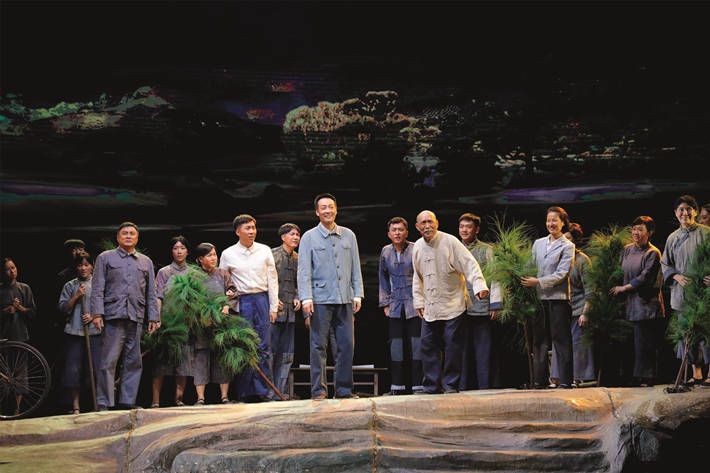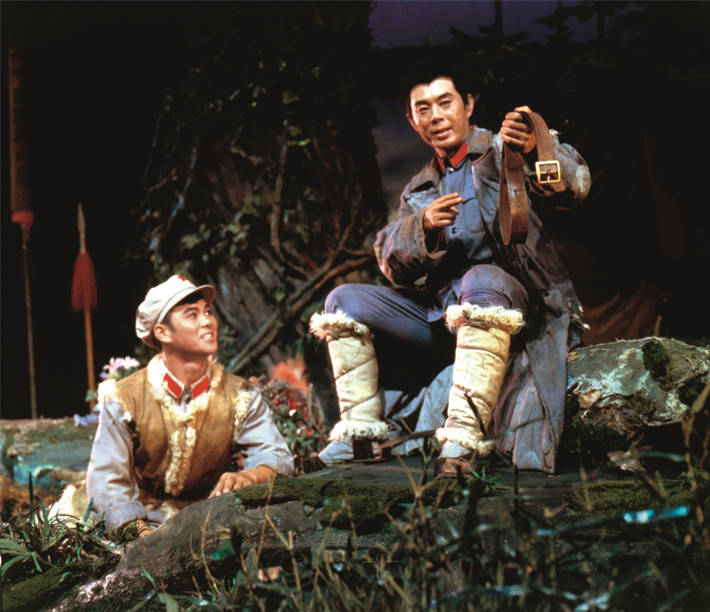100 Years of Red-Themed Dramas

Chinese historical revolutionary theater has become a timeless genre. Historical records indicate that after the Nanchang Uprising on August 1, 1927, several drama enthusiasts within the Red Army were already rehearsing short plays in the intervals between battles and during the march south, which set the stage for wider Red Army theatrical practices. In 1931, a central revolutionary base was founded in Ruijin, Jiangxi Province. A group of theater practitioners gathered there, and the Red Army gradually won the trust and support of the local people through dramatic performances.
During the Long March (1934-1936), actors among Red Army soldiers performed sketches between battles. March North to Resist Japanese Aggression and Becoming a Red Army Soldier were two of the most popular theatrical pieces to emerge among soldiers and folks at that time. At the Yan’an revolutionary base, military drama maintained strong developmental momentum.

A still from Gu Wenchang. From July 14 to 18, 2021, Gu Wenchang, an original drama from the National Theatre of China, was staged. The drama, to some extent, broke the chronological narrative routine in favor of a vivid, simple, and touching model. Its success is worthy of applause. by Wang Haochen/National Theatre of China
Precious revolutionary cultural resources became fertile soil for literature and art in New China and an important cultural foundation for future creation. After the founding of the People’s Republic of China in 1949, a series of dramas were staged to highlight the bravery, tenacity, and revolutionary spirit of Red Army soldiers. For example, Across Rivers and Mountains, a drama staged in 1956, was written by Chen Qitong, who joined the Long March as a 15-year-old Red Army soldier. He artistically traced the Long March after experiencing it personally, which enabled him to deftly capture important scenes such as crossing the Yi area and the Dadu River, climbing snowy mountains, and traversing grassland. Another drama, Sister Jiang, staged in 1964, depicted a female communist jailed by Kuomintang authorities. Loyal to the Party till the end, she rejects coercion, bribery, and all forms of torture. On the eve of the total victory of the revolution, she marches to the gallows beaming with hope for New China. Such works paid tribute to the revolution and praised its players’ heroism and idealism.
Over the past century, historical red-themed dramas have continued to focus on the revolutionary struggle in the Jinggang Mountain, the Long March, and other major historical themes and heroes. For example, Sanwan, That Night, which premiered at the National Theatre of China in January 2019, stressed the importance of adhering to the leadership of the Communist Party of China (CPC) in a critical time when the Chinese revolution fell into crisis. A 1927 attack by the Kuomintang army relegated the Red Army to guerrilla tactics in the Jinggang Mountain, which was severely demoralizing. Mao Zedong presided over reorganization of the army in Sanwan, where the organizational structure of “building Party branches in each company” emerged to save the Red Army and the Party at a critical moment.

After the founding of the People’s Republic of China in 1949, many classic plays about the Long March were staged to pass its spirit from generation to generation.The picture shows rehearsal of a Long March drama titled Across Rivers and Mountains in 2007. The original drama premiered in 1956. by Gao Mingyi/CFB
It should be noted that in more recent dramatic works, the revolutionary romanticism and optimism that Chen Qitong and other older playwrights sought to depict has been gradually replaced by reflections on stories of Chinese communists sacrificing their lives for the lofty ideals they pursued. Contemporary plays tend to highlight choices made in life-and-death situations to explore human nature. They seek to deliver historical insight and ideological enlightenment. For example, the epic drama Yuhuatai was staged by the Nanjing Drama Troupe in 2015 as a group portrait of heroic Party members and heroes such as Yun Daiying (1895-1931), Xu Baoye (1900-1935), and Shi Huang (1900-1934). Those figures chose death over betraying their commitment to the revolutionary cause.
Other dramas have focused on heroes and models in the period of socialist construction who devoted their lives to the great cause of national development. For example, Gu Wenchang centers on a county Party secretary in the 1950s. Facing an underdeveloped economy on infertile land in Dongshan County, Fujian Province, Gu Wenchang leads the local people to find new water sources, plant trees, control desertification, and build dams, gradually transforming a poor and backward fishing village into a picturesque paradise.

The drama Lei Feng, staged in 1963, captures soldier Lei Feng’s spirit of serving the people wholeheartedly. CFB
This year, Chinese stages premiered many plays featuring heroes like Mao Fengmei, a village Party chief in A Monument of Hard Work who devoted all her energy to the villagers, Guo Yonghuai, a leading scientist on the “Two Bombs, One Satellite” program who died with his assistant in a plane crash while protecting crucial documents as depicted in The Stars Tonight, and Liu Qing, deputy secretary of a county Party committee in an eponymous drama who lived in the countryside for 14 years and wrote the epic novel The Builders on the agricultural cooperation movement in rural China. Such plays are based on real figures who fueled the development of the People’s Republic of China.
Outstanding theater works are looking at the glorious history of the CPC from different perspectives to explore the image of Party members and organizations based on the unique characteristics of the times. With creative cultural interpretation and stage dynamics, they are bringing new cultural themes and artistic enjoyment to audiences of different ages and nationalities. Literary and art classics, new and old, are being handed down to later generations, and more new works are on the way.
The author is director of the theater research center of the Chinese National Academy of Arts.